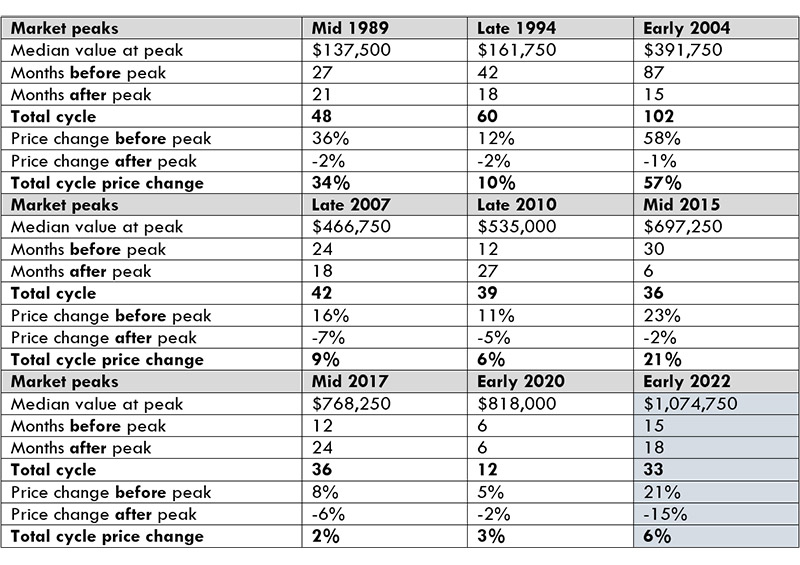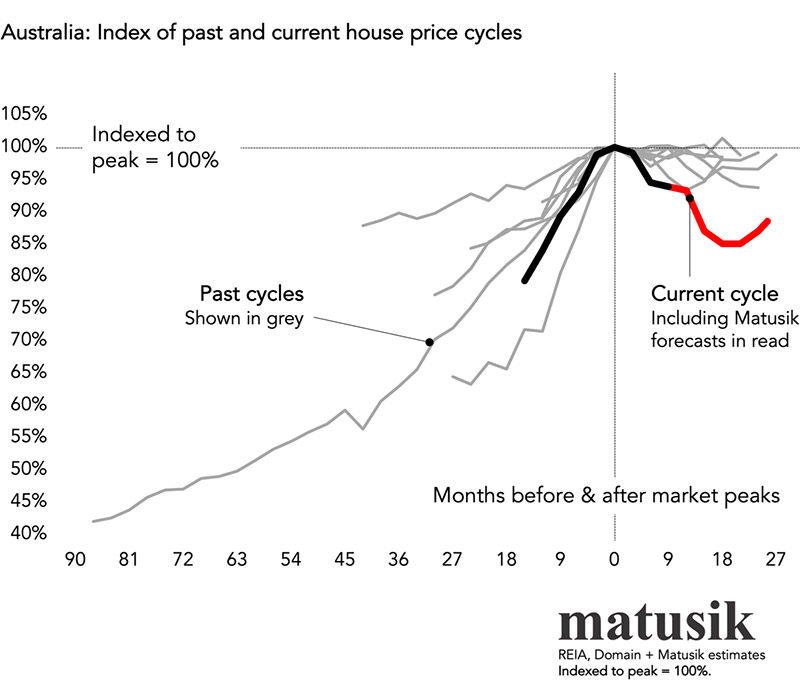More property price pain tipped before any correction
Renowned independent housing market analyst Michael Matusik has joined API Magazine’s panel of highly regarded contributors, renewing a relationship that began many years ago. In his first article of 2023, Mr Matusik makes a bold prediction about how far property prices can expect to fall this year.
For those with a long memory, you might recall that I used to write a regular column for API Magazine back when it was hard copy. In fact, the publication launched the same week I started my business.
But enough of the past. Let’s discuss the future. I renew my acquaintance with API Magazine’s readership outlining what I think will happen to Australia’s housing prices over the next 12 to 18 months.
It’s worth taking a minute or two to peruse the table and graph that follow.
Both graphics show the past nine house price cycles across Australia.

Source: Matusik, REIA, Domain.
The current cycle – shown in black and red on the graph below and inside the light blue box in the table above – peaked early last year, with a median Australian house sales price of just under $1.1 million.

The median house sales price rose by 21 per cent over the 15 months leading up to the early 2022 market peak. I will go out on a limb here and say that I believe the median Australian house sales price will decline by 15 per cent from the $1.074 million peak in the second half of calendar 2023.
Housing values should start to rise in early 2024, and the median Australian house sales price could be close to $965,000 by June next year. This is still down 10 per cent on the previous market peak.
It will probably take another year or so for median Australian house sales price to break the $1 million barrier again.
Some economists and commentators are stating a 20 per cent, or even a 25 per cent, fall from last year’s peak is on the cards.
If that happens, that will bring median house values back to where they were at the start of this current cycle in late 2020.
A similar recoil has not happened before in the other eight cycles illustrated in this post.
What actually happens depends a lot on inflation and interest rates.
Property in for difficult year
Right now, the overall market conditions in 2023 look set to be difficult when it comes to the Australian housing market, with official interest rates rising to 3.35 per cent in just nine months.
Yet, the second half of 2023 – to me – looks better than the first half of this year, with interest rate rises over and confidence returning to the housing sector.
Leading indicators show that inflation is already stabilising, and when applying labour force figures that you can trust, unemployment is rising and sharply.
In short, the recent interest rate rises are having an impact.
I expect the Reserve Bank of Australia (RBA) to lift the cash rate to 3.6 per cent - that’s one more 0.25 per cent lift – sometime over the next couple of months and then rest.
America’s economic influence
Importantly, the United States election in early 2024 is likely to have an impact on interest rates and with all things being equal the US is likely to start lowering the cash rate in late 2023.
The RBA has in the past followed the US Federal Reserve when it comes to interest rate movements.
For now, I think the cash rate is likely to be around 2.5 per cent by the middle of 2024.
That’s a 1.0 per cent drop from where they are likely to rise to by Easter this year. And I wouldn’t be that surprised if the first drop – likely in November this year – is a 0.5 per cent fall.
But, as with any crystal ball gazing, the usual Ts and Cs apply!




















